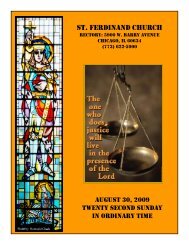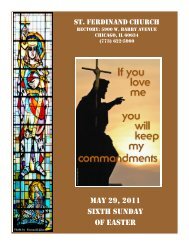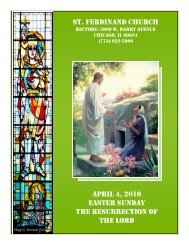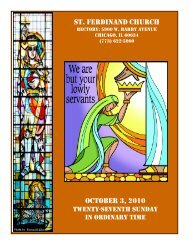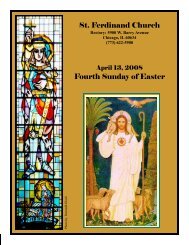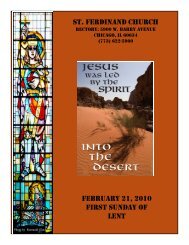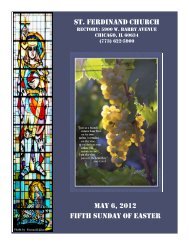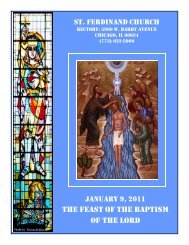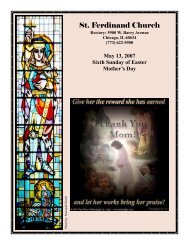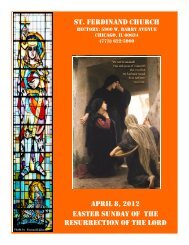june 19, 2011 the solemnity of the most holy trinity - Parafia Åw ...
june 19, 2011 the solemnity of the most holy trinity - Parafia Åw ...
june 19, 2011 the solemnity of the most holy trinity - Parafia Åw ...
You also want an ePaper? Increase the reach of your titles
YUMPU automatically turns print PDFs into web optimized ePapers that Google loves.
June <strong>19</strong>, <strong>2011</strong> Holy Trinity Sunday Page Four<br />
Background on and Changes in <strong>the</strong> New Translation <strong>of</strong> <strong>the</strong> Roman Missal<br />
by Msgr. James P. Moroney<br />
P<br />
ope John Paul II presented <strong>the</strong> Church with a gift for <strong>the</strong> millennium: <strong>the</strong> third edition <strong>of</strong> <strong>the</strong> Missale Romanum (Roman<br />
Missal) since <strong>the</strong> Second Vatican Council. The Roman Missal is <strong>the</strong> book that sits on <strong>the</strong> altar at Mass and contains all <strong>the</strong><br />
prayers and a description <strong>of</strong> <strong>the</strong> actions that make up <strong>the</strong> celebration <strong>of</strong> <strong>the</strong> Mass, “<strong>the</strong> source and summit <strong>of</strong> <strong>the</strong> entire<br />
Christian Life.” Along with this new missal, <strong>the</strong> Congregation for Divine Worship and <strong>the</strong> Discipline <strong>of</strong> <strong>the</strong> Sacraments provided<br />
us with an entirely new instruction on <strong>the</strong> translation <strong>of</strong> liturgical texts entitled Liturgiam Au<strong>the</strong>nticam. This instruction, <strong>the</strong> fruit<br />
<strong>of</strong> decades <strong>of</strong> consultation, describes a new way <strong>of</strong> translating that is more capable <strong>of</strong> conveying <strong>the</strong> meaning, beauty, and form <strong>of</strong><br />
<strong>the</strong> ancient Latin prayers. Indeed, <strong>the</strong> vast majority <strong>of</strong> <strong>the</strong> prayers we pray at Mass have been preserved by <strong>the</strong> Latin Church for<br />
more than a thousand years and help not only to hand on what we believe but also to make clear who we are.<br />
The prayers <strong>of</strong> <strong>the</strong> Roman Missal serve an indispensable role in passing on <strong>the</strong> faith,<br />
for, as <strong>the</strong> ancient axiom lex orandi, lex credendi reminds us, what we pray is what we<br />
believe. The au<strong>the</strong>ntic translation <strong>of</strong> <strong>the</strong>se prayers, <strong>the</strong>refore, plays an important role in<br />
<strong>the</strong> catechetical life <strong>of</strong> <strong>the</strong> Church. Thanks to <strong>the</strong> new Roman Missal and <strong>the</strong> instruction<br />
Liturgiam Au<strong>the</strong>nticam, <strong>the</strong> Church in <strong>the</strong> English-speaking world will receive a<br />
new translation <strong>of</strong> <strong>the</strong> Mass, beginning with <strong>the</strong> First Sunday <strong>of</strong> Advent <strong>of</strong> <strong>2011</strong>.<br />
How Did a New Translation Come About<br />
The principles <strong>of</strong> translation by which our present liturgical books were rendered into<br />
English were first articulated in <strong>the</strong><strong>19</strong>68 instruction Comme le prévoit. Although admirable<br />
in its attempts to enthusiastically and creatively render a text into modern forms<br />
<strong>of</strong> English, <strong>the</strong> <strong>19</strong>68 instruction’s reliance on <strong>the</strong> subjective judgments <strong>of</strong> <strong>the</strong> translator<br />
<strong>of</strong>ten ended up with a time-bound translation influenced by <strong>the</strong> translator’s <strong>the</strong>ological<br />
presuppositions. In <strong>the</strong> subsequent decades, a new way <strong>of</strong> translating evolved that<br />
engaged a variety <strong>of</strong> experts, from Latinists and patrologists to <strong>the</strong>ologians and pastors,<br />
musicians and poets, and specialists in English literature. Such a collaborative model<br />
<strong>of</strong> translation sought to reach a final product that was at once more precise and more memorable. It was a task as ambitious as <strong>the</strong><br />
process to achieve it was complex.<br />
The first agent <strong>of</strong> liturgical translation is <strong>the</strong> conference <strong>of</strong> bishops, which is charged by <strong>the</strong> Council Fa<strong>the</strong>rs with <strong>the</strong> translation<br />
and approval <strong>of</strong> liturgical texts. Bishops, however, are not necessarily translators, so experts need to be engaged to accomplish this<br />
work. For this purpose, <strong>the</strong> Holy See forms mixed commissions at <strong>the</strong> requests <strong>of</strong> <strong>the</strong> conferences <strong>of</strong> bishops, organizations devoted<br />
exclusively to <strong>the</strong> development <strong>of</strong> translations <strong>of</strong> liturgical texts into a common language. The mixed commission for <strong>the</strong><br />
English language is called <strong>the</strong> International Commission on English in <strong>the</strong> Liturgy (ICEL) and is made up <strong>of</strong> <strong>the</strong> eleven major conferences<br />
<strong>of</strong> bishops where English is spoken. ICEL’s chairman is Bishop Arthur Roche <strong>of</strong> Leeds, and <strong>the</strong> U.S. representative is<br />
Bishop Arthur Serratelli <strong>of</strong> Paterson. ICEL is located on Connecticut Avenue in Washington, D.C., but it employs specialists from<br />
around <strong>the</strong> English-speaking world to assist in its work <strong>of</strong> translating <strong>the</strong> Latin liturgical books into <strong>the</strong> sort <strong>of</strong> English that is spoken<br />
today.<br />
Over <strong>the</strong> past decade, our conference <strong>of</strong> bishops, <strong>the</strong> United States Conference <strong>of</strong> Catholic Bishops, has reviewed translations <strong>of</strong><br />
<strong>the</strong> Roman Missal produced by ICEL in several different forms. In November 2009, <strong>the</strong> bishops approved <strong>the</strong> last <strong>of</strong> <strong>the</strong> twelve<br />
segments <strong>of</strong> <strong>the</strong> Roman Missal by <strong>the</strong> requisite two-thirds vote <strong>of</strong> all de iure Latin rite members. The Congregation for Divine<br />
Worship and <strong>the</strong> Discipline <strong>of</strong> <strong>the</strong> Sacraments, essentially <strong>the</strong> Pope’s Liturgy Office, hold <strong>the</strong> responsibility <strong>of</strong> reviewing all translations<br />
<strong>of</strong> liturgical texts that have been apprThe entire Church in <strong>the</strong> United States has been blessed with this opportunity to<br />
deepen its understanding <strong>of</strong> <strong>the</strong> Sacred Liturgy, and to appreciate its meaning and importance in our lives oved by conferences <strong>of</strong><br />
bishops. Cardinal Antonio Cañizares Llovera serves as prefect to that congregation, while two native English speakers—<br />
Archbishop J. Augustine DiNoia, OP, and Reverend Anthony Ward, SM—serve as secretary and undersecretary, respectively. So<br />
important is <strong>the</strong> task <strong>of</strong> confirmation <strong>of</strong> <strong>the</strong> Roman Missal, that with <strong>the</strong> advent <strong>of</strong> <strong>the</strong> instruction Liturgiam Au<strong>the</strong>nticam, <strong>the</strong> congregation<br />
undertook <strong>the</strong> formation <strong>of</strong> a committee <strong>of</strong> advice on <strong>the</strong> question <strong>of</strong> <strong>the</strong> translation <strong>of</strong> English-language liturgical texts.<br />
That committee is chaired by Cardinal George Pell <strong>of</strong> Sydney and is composed <strong>of</strong> senior prelates from all around <strong>the</strong> Englishspeaking<br />
world. On March 25, 2010, <strong>the</strong> English language edition <strong>of</strong> <strong>the</strong> Roman Missal was confirmed (Prot 269/10/LIn), an<br />
event commemorated by a luncheon with <strong>the</strong> Vox Clara Committee in <strong>the</strong> presence <strong>of</strong> <strong>the</strong> Holy Fa<strong>the</strong>r.<br />
Starting this week, a series <strong>of</strong> articles regarding <strong>the</strong> changes to <strong>the</strong> Roman Missal will be published in our bulletin in<br />
preparation for <strong>the</strong> upcoming implementation, as well as to deepen our understanding <strong>of</strong> <strong>the</strong> Sacred Liturgy, and to<br />
appreciate its meaning and importance in our lives.



